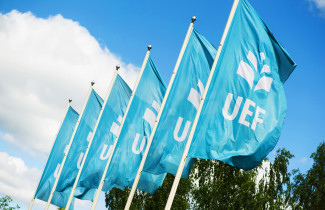An international research collaboration has developed promising new materials that could improve the manufacturing of electronic displays.
The study, published in Communications Chemistry, introduces a simpler and more cost-effective approach to producing blue OLED displays used in smartphones, tablets and televisions.
The research team, led by Dr Alexander Romanov at the University of Manchester, included valuable theoretical contributions from Professor Mikko Linnolahti and Doctoral Researcher Nguyen Le Phuoc at the University of Eastern Finland. The UEF team's expertise in computational chemistry helped elucidate the electronic properties and behaviour of the newly developed materials.
The study focuses on a new class of materials that can produce efficient blue light through a simplified synthesis process. While current methods typically require multiple complex steps and expensive materials, this new approach achieves comparable or even better performance in a single step. In testing, the materials demonstrated 21% efficiency in converting electricity to light while producing a purer blue colour than existing technologies.
The research was supported by several funding bodies, including the Research Council of Finland Flagship Programme for Photonics Research and Innovation, PREIN. The work demonstrates the value of international collaboration in materials science and photonics research.
This development represents a promising advance toward more sustainable and cost-effective manufacturing of electronic displays, with potential implications for future device efficiency and longevity.
For further information, please contact:
Professor Mikko Linnolahti, tel. +358 50 5926855 mikko.linnolahti@uef.fi
Article:
Charlotte Riley, Hwan-Hee Cho, Alexander C. Brannan, Nguyen Le Phuoc, Mikko Linnolahti, Neil C. Greenham & Alexander S. Romanov. High triplet energy host material with a 1,3,5-oxadiazine core from a one-step interrupted Fischer indolization. Communications Chemistry. Volume 7, Article number: 298 (2024). https://www.nature.com/articles/s42004-024-01377-y





